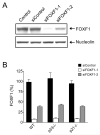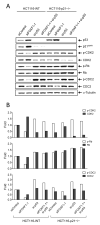The p53-p21WAF1 checkpoint pathway plays a protective role in preventing DNA rereplication induced by abrogation of FOXF1 function
- PMID: 21964066
- PMCID: PMC3205208
- DOI: 10.1016/j.cellsig.2011.09.017
The p53-p21WAF1 checkpoint pathway plays a protective role in preventing DNA rereplication induced by abrogation of FOXF1 function
Abstract
We previously identified FOXF1 as a potential tumor suppressor gene with an essential role in preventing DNA rereplication to maintain genomic stability, which is frequently inactivated in breast cancer through the epigenetic mechanism. Here we further addressed the role of the p53-p21(WAF1) checkpoint pathway in DNA rereplication induced by silencing of FOXF1. Knockdown of FOXF1 by small interference RNA (siRNA) rendered colorectal p53-null and p21(WAF1)-null HCT116 cancer cells more susceptible to rereplication and apoptosis than the wild-type parental cells. In parental HCT116 cells with a functional p53 checkpoint, the p53-p21(WAF1) checkpoint pathway was activated upon FOXF1 knockdown, which was concurrent with suppression of the CDK2-Rb cascade and induction of G(1) arrest. In contrast, these events were not observed in FOXF1-depleted HCT116-p53-/- and HCT116-p21-/- cells, indicating that the p53-dependent checkpoint function is vital for inhibiting CDK2 to induce G(1) arrest and protect cells from rereplication. The pharmacologic inhibitor (caffeine) of ataxia telangiectasia mutated (ATM) and ataxia telangiectasia and Rad3 related (ATR) protein kinases abolished activation of the p53-p21(WAF1) pathway upon FOXF1 knockdown, suggesting that suppression of FOXF1 function triggered the ATM/ATR-mediated DNA damage response. Cosilencing of p53 by siRNA synergistically enhanced the effect of FOXF1 depletion on the stimulation of DNA rereplication and apoptosis in wild-type HCT116. Finally, we show that FOXF1 expression is predominantly silenced in breast and colorectal cancer cell lines with inactive p53. Our study demonstrated that the p53-p21(WAF1) checkpoint pathway is an intrinsically protective mechanism to prevent DNA rereplication induced by silencing of FOXF1.
Copyright © 2011 Elsevier Inc. All rights reserved.
Figures







Similar articles
-
Chk1 is dispensable for G2 arrest in response to sustained DNA damage when the ATM/p53/p21 pathway is functional.Oncogene. 2011 Oct 13;30(41):4261-74. doi: 10.1038/onc.2011.135. Epub 2011 May 2. Oncogene. 2011. PMID: 21532626
-
An ATM- and Rad3-related (ATR) signaling pathway and a phosphorylation-acetylation cascade are involved in activation of p53/p21Waf1/Cip1 in response to 5-aza-2'-deoxycytidine treatment.J Biol Chem. 2008 Feb 1;283(5):2564-74. doi: 10.1074/jbc.M702454200. Epub 2007 Oct 31. J Biol Chem. 2008. PMID: 17977830
-
The PARP inhibitor PJ34 causes a PARP1-independent, p21 dependent mitotic arrest.DNA Repair (Amst). 2011 Oct 10;10(10):1003-13. doi: 10.1016/j.dnarep.2011.07.006. Epub 2011 Aug 12. DNA Repair (Amst). 2011. PMID: 21840268 Free PMC article.
-
Protective mechanisms of p53-p21-pRb proteins against DNA damage-induced cell death.Cell Cycle. 2008 Feb 1;7(3):277-82. doi: 10.4161/cc.7.3.5328. Epub 2007 Nov 18. Cell Cycle. 2008. PMID: 18235223 Review.
-
Mechanisms to control rereplication and implications for cancer.Curr Opin Cell Biol. 2007 Dec;19(6):663-71. doi: 10.1016/j.ceb.2007.10.007. Epub 2007 Nov 28. Curr Opin Cell Biol. 2007. PMID: 18053699 Free PMC article. Review.
Cited by
-
Thymidylate synthase expression and p21(WAF1)/p53 phenotype of colon cancers identify patients who may benefit from 5-fluorouracil based therapy.Cell Oncol (Dordr). 2014 Feb;37(1):17-28. doi: 10.1007/s13402-013-0159-z. Epub 2013 Nov 26. Cell Oncol (Dordr). 2014. PMID: 24277474 Free PMC article.
-
The dual role of FOXF2 in regulation of DNA replication and the epithelial-mesenchymal transition in breast cancer progression.Cell Signal. 2016 Oct;28(10):1502-19. doi: 10.1016/j.cellsig.2016.06.021. Epub 2016 Jul 1. Cell Signal. 2016. PMID: 27377963 Free PMC article.
-
Identical effects of VEGF and serum-deprivation on phenotype and function of adipose-derived stromal cells from healthy donors and patients with ischemic heart disease.J Transl Med. 2013 Sep 18;11:219. doi: 10.1186/1479-5876-11-219. J Transl Med. 2013. PMID: 24047149 Free PMC article.
-
EZH2 silencing with RNA interference induces G2/M arrest in human lung cancer cells in vitro.Biomed Res Int. 2014;2014:348728. doi: 10.1155/2014/348728. Epub 2014 Mar 18. Biomed Res Int. 2014. PMID: 24745014 Free PMC article.
-
Genetic polymorphisms are associated with the risk of gastric and colorectal cancers in a Han Chinese population.Oncotarget. 2017 Apr 25;8(17):28805-28811. doi: 10.18632/oncotarget.15745. Oncotarget. 2017. PMID: 28404937 Free PMC article.
References
Publication types
MeSH terms
Substances
Grants and funding
LinkOut - more resources
Full Text Sources
Research Materials
Miscellaneous

